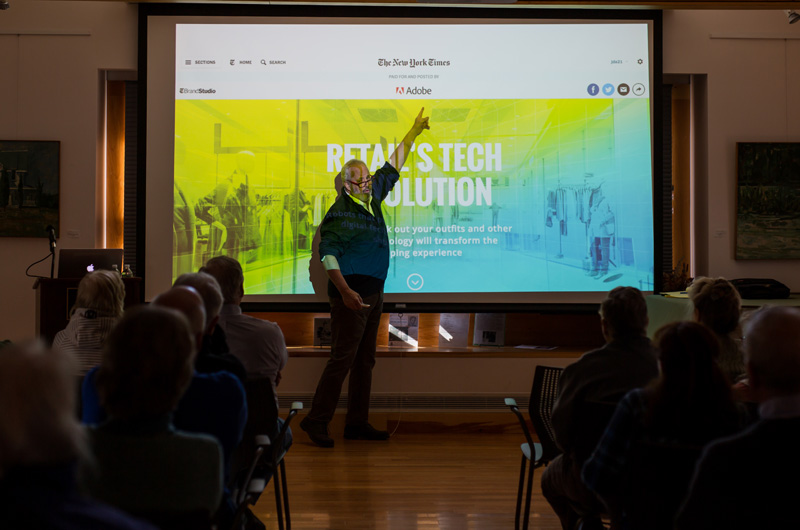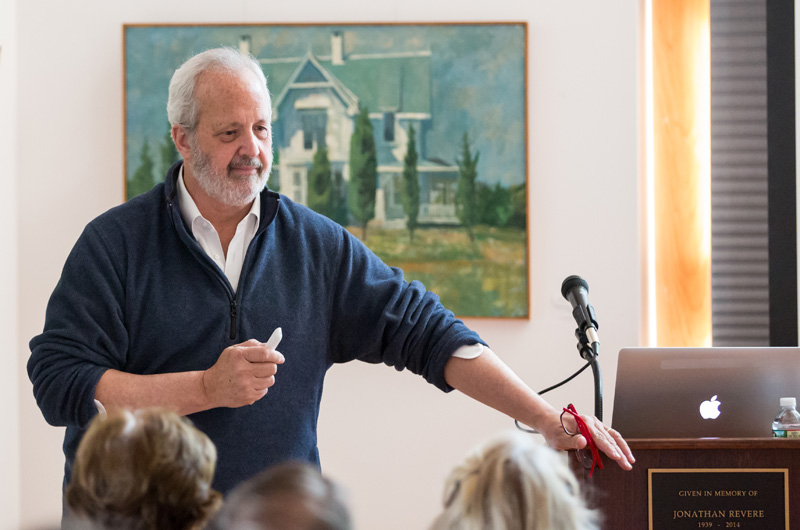Animals escape from the Central Park Zoo and wreak havoc on New York City in broad daylight. An astronomer discovers life on the moon. Hillary Clinton adopts an alien baby.
Apart from bringing to mind a trip through the checkout line at Stop and Shop, these news stories have one predictable thing in common: They are fake. It doesn’t take much to discern stories like this from the truth, but sometimes it’s not so easy.
In 1980, the Washington Post ran a story about Jimmy, an eight-year-old heroin addict living with his mother and her boyfriend in Washington, D.C. Only after the reporter won a Pulitzer Prize for the story in 1981 was it discovered to have been a fabrication.
At a well-attended talk at the West Tisbury library on Saturday, journalist and educator John Kennedy discussed the origins and implications of fake news, and offered a prescription for how citizens can stay afloat in a sea of often misleading online information.
“Fake news” has become a household term since the 2016 presidential election, with much debate over whether false or misleading news stories benefitted Donald Trump as a candidate. But the concept of fake news is nothing new.
Saturday’s talk brushed over centuries of news history, starting with the printing-press technology advanced by Johannes Gutenberg in the 1400s, and the modern concepts of objectivity and balance that people often associate with professional journalism.
Much has changed since Gutenberg — especially since the 1990s with the advent of the internet and social media.
“Everyone now has a printing press,” said Mr. Kennedy, who teaches media law and ethics at Boston University.
He noted that people tend to gravitate toward the facts and opinions they agree with. The creation of social and intellectual bubbles through online media — and the ability of anyone to reach a wide audience — has cultivated a fertile ground for fake news, he said.
Add to the mix a widespread distrust for institutions — and a U.S. president who has branded mainstream media outlets such as the New York Times and CNN as fake news — and many people may find themselves groping for news they can trust. Compounding the problem is our tendency to trust those closest to us, regardless of their sources.
Mr. Kennedy noted that fake news means different things to different people. He outlined a number of common fake news varieties and the motivations for creating them: parody, partisan politics, propaganda and of course profit.
He highlighted a few recent cases, including a story by the satirical newspaper The Onion headlined: “Kim Jong-Un Named The Onion’s Sexiest Man Alive For 2012.” The Chinese news agency People’s Daily apparently missed the joke and ran the story verbatim on its English-language website.
Some fake news stories have gone down in history. Mr. Kennedy noted a six-part series in The Sun, a former New York daily newspaper, in 1835 documenting the discovery of life on the moon. The series included detailed illustrations of humanoid creatures with wings frolicking in a bucolic moon landscape. It was several weeks before the series was revealed as a hoax.

Much of the discussion on Saturday dwelled on strategies for dealing with fake news. Mr. Kennedy noted online tools such as extensions for the Google Chrome browser that can identify dubious articles online, and the efforts of the Washington Post, PolitiFact, Snopes and other organizations to fact-check stories and statements and publish their findings.
But he stressed the importance of consumer awareness. Showing a slide of Mister Rogers standing over his Neighborhood of Make-Believe, he encouraged people to “know the information neighborhood.” (One audience member recalled a false news story years ago claiming that Mr. Rogers wore sweaters to hide the tattoos he obtained in the military; Mr. Rogers was not known to have served in the military or to have had any tattoos.)
The acronym IMVAIN has been used to help students evaluate news sources: Consider the (I)ndependence of the source; (M)ultiple sources are better than one; favor sources that (V)erify rather than assert; (A)uthorized and (I)nformed sources are best; and (N)amed sources add credibility. Mr. Kennedy offered a crash course in the method on Saturday, inviting the group to practice their skills on a video involving a stuntman skydiving without a parachute. It was an easy target, although one person admitted to feeling nervous as a viewer.
A question-and-answer period touched on other possible solutions, including a universal stamp of approval akin to the Good Housekeeping Seal. Mr. Kennedy said any attempts at licensing the news would likely run into issues of free speech, although he pointed out that some trade groups and news organizations have their own codes of ethics.
He and others emphasized the importance of education, advocating for media literacy curriculums as early as elementary school.
“It’s not a static process,” Mr. Kennedy said of the constant stream of news that reaches our senses. “You can’t turn off your critical thinking.”





Comments (1)
Comments
Comment policy »